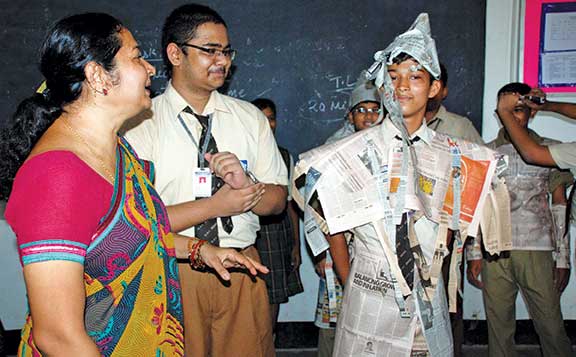Payal Bedi
The significance of communication in any professional field can’t be stressed enough but its importance in the teaching profession is unmatched. After all, a teacher is dealing with a number of children every day and she needs to bridge so many gaps. It is the effectiveness of communication in a classroom that determines the effectiveness of teaching and learning. Not just that, it ensures that rules are followed and the class and time are managed well.
A teacher must possess exceptionally good communication skills because she has to reach out to a number of children of different backgrounds in every class. Good communication sets the right tone for a class. It signals the kind of behaviour expected from the students. This not only ensures the smooth functioning of a class but also makes sure that there is a positive learning environment helping students achieve their best. This also strengthens the bond between the teacher and the student.
Communication can be verbal as well as non-verbal. Both are indispensable in a classroom. Non-verbal communication refers to the body language – physical cues, facial expressions and gestures – of a person. Verbal communication should be accompanied by the right tone of voice. Being respectful is essential while communicating, choosing words that are effective yet polite.
Declare the rules
Despite going to the class prepared, many a time teachers are not able to deliver effectively because they are not able to manage the classroom, which is the result of a lack of communication between the teacher and the students. It’s crucial to establish the rules in class. This will give students a fair idea of what is acceptable and what is not. The teacher’s gestures, body language too can give cues to the students as to the kind of behaviour expected from them. A stare of disapproval or a smile of agreement sometimes conveys more than words. The teacher needs to be assertive both with her words as well as her gestures.

Two-way communication
Communication can’t be effective if it is one-sided. The teacher needs to be a good listener too. Lending an empathetic ear to the speaker, having eye contact and an unwavering focus on the speaker is equally important. It’s important not to interrupt the speaker while talking. This is a respectful gesture. It boosts the confidence of the speaker and the speaker also learns the kind of behaviour that needs to be exhibited when someone is talking.
The art of asking questions
Learning to speak or communicate is the first step towards asking questions. Questions need to be framed thoughtfully to obtain the expected answers. It’s important to expand the thinking horizons of the students by including ‘what if’, ‘analyze’ or ‘create’ in the questions. This can lead to many unanticipated and astounding answers. Such questions will help children be imaginative and creative in their journey of exploration.
Making learning fun
It’s the teacher who touches and moulds the lives of students for the better. The class is like a stage and the teacher can choose to be whatever character she feels like portraying. Creating drama and magic in class will not only mesmerize the students but also make learning fun. Voice modulation and intonation helps the students stay involved for long. Apart from making the class more engaging, it will also increase the teacher’s involvement, which in turn will have a positive impact on the children.
Communicating with peers
Communication with peers is imperative in a classroom. Group discussion, activities and games strengthen the bond in the peer group. Peer learning is an effective mode of learning in class. Students need to be respectful towards each other while communicating. They should know the kind of words they can use. The usage of words like thank you, please and sorry must be encouraged and appreciated.
Disagreeing productively
It’s important that the day-to-day disagreements and conflicts are dealt with positively in the classroom. The teacher’s role is crucial in making the children understand that it’s absolutely alright to disagree with the other person as different people will have different opinions. It’s a good idea to have a ‘conflict corner’ in class. Students, when disagreeing with each other, can go to that corner, discuss the points they want to clarify and resolve the issue amongst themselves amicably with the help of the teacher.
Words of motivation
Words of motivation help children in overcoming their fears and apprehensions. Children draw inspiration from their teacher. Words chosen by the teacher should be a right mix of both encouragement and criticism that can inspire the student to do his best. As a teacher one gets an opportunity to peep into so many lives. One should consider it an opportunity to touch and inspire young individuals.
The author is started her teaching career in 2007. A self-motivated and accomplished professional, she believes that learning is an ongoing process and one needs to evolve with the changing times. Currently, she is working as an Academic Coordinator in Smart Wonders School, Mohali. She can be reached at payalbedi8@gmail.com.
